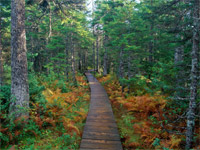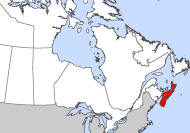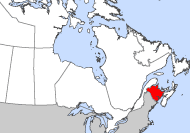![]()
Land | Climate | People | Economy | Transportation | Getting Here

| Capital | Fredricton |
| Official Languages | English, French |
| Population | 749,168 |
| Time Zone | UTC-4 |
New Brunswick is the PICTURE PROVINCE of Canada, and also the gateway to Atlantic Canada. It borders on the State of Maine and the provinces of Quebec and Nova Scotia. Its capital is Fredericton, its largest city the old Loyalist seaport of Saint John.
New Brunswick's coastline is lapped by four bodies of salt water: the Bay of Chaleur, the Gulf of St. Lawrence, the Northumberland Strait and the Bay of Fundy. Its forests cover more than four-fifth of the province. Several world-famous salmon rivers, countless lakes, streams and brooks offer an abundance of water sports and recreational activities.
New Brunswick is for all seasons with colourful summer festivals, breath-taking fall foliage, the sparkle of freshly fallen snow, and maple sugar parties. Antique auctions and fine quality handcrafts are never out of season.
New Brunswick is a spectacularly beautiful place to relax and enjoy with its benign climate - continental, which prevails in the interior, or the more temperate coastal climate.
Land
 Fundy National Park
Fundy National Park New Brunswick, the largest of Canada's three Maritime Provinces, is nestled under Quebec's Gaspé Peninsula and beside the American State of Maine. Its northern border also includes the Restigouche River and the Baie des Chaleurs. The eastern boundary is entirely coastal - the Gulf of St. Lawrence and Northumberland Strait - and delightfully dotted with warm, sandy beaches...the warmest salt water north of Virginia. Chignecto Bay and the 24-kilometre (15-mile) wide Isthmus of Chignecto, which connects New Brunswick to Nova Scotia, form part of New Brunswick's southern border. The rest of it is the Bay of Fundy. Its tides - the highest and wildest in the world - have carved a spectacular coastline.
New Brunswick, with an area of 73,440 sq km (28,355 sq mi), is the eighth largest province in Canada.
About 80% of the province is forested, with the other 20% consisting of agricultural land and urban areas. The major urban centres lie in the south of the province.
The province is roughly rectangular in shape, and its extreme dimensions are about 370 km (about 230 mi) from north to south and about 305 km (about 190 mi) from east to west. Elevations range from sea level to 820 m (2690 ft) atop Mt. Carleton. The province has a total shoreline of 2269 km (1410 mi).
Climate
Sunny Maritimes
 Shoreline of New Brunswick
Shoreline of New Brunswick New Brunswick has some of the sunniest places in Atlantic Canada: Chatham is the only station in the region to record an average of 2000 hours a year. Perhaps the most surprising statistic is that Saint John in December reports nearly 100 hours of bright sunshine on average, more than any other station in eastern Canada! On the other hand, in July it reports one of the lowest sunshine totals in Canada. Across New Brunswick in an average year, sunless days number 75 and sunny days number between 140 and 160.
No part of New Brunswick lies more than 200 km from the ocean, yet the province has a typically continental flavour to its climate. During the winter, cold air, largely unaltered, frequently flows across New Brunswick from the centre of North America, and most storms affecting the province originate either over the North Pacific or the Gulf of Mexico. In summer, the predominant air mass is warm continental, with occasional incursions of hot, humid air from the Gulf of Mexico. On the other hand, influxes of moist Atlantic air produce mild spells in winter and periods of cool weather in summer.
Northwestern and central New Brunswick are the parts of the province that are least affected by the ocean. The north and east shores are modified by the Gulf of St. Lawrence, but less so than their proximity might suggest. The extent of the sea-effect depends to a large degree on the wind direction, with onshore winds causing the most moderation. The cold Gulf waters retard warming of the air in spring, keep the summer maximum temperature low, and provide a slight warming of the air in fall--provided the winds are off the water. Near the Bay of Fundy, continental air masses are modified by the ocean. Coastal locations such as St. Andrews and Saint John experience moist Atlantic air most of the year, producing mild periods during the winter and cool weather the rest of the year.
Yet, in spite of their by-the-sea location, New Brunswick coastal areas are not good examples of true marine climates. Continental climates, compared with true maritime climates, have an earlier spring and shorter fall, wider fluctuations of temperature from day to day and from season to season, and more snowfall but less total precipitation. Near the coast there is a blending of these continental and maritime influences, with the temperature moderating effect of the ocean increasing the closer we get to the coast.
There are two key indicators that tell us whether a climate is influenced more by the ocean or by the land in northern latitudes. The first is the season of maximum precipitation: in marine climates it is the cold season. The second is the percentage of the total annual precipitation that falls as snow: less than 25% for marine areas. Saint John's climate qualifies as marine on both counts.
Temperature: A Province of Contrasts
January is the coldest month in New Brunswick and July is the warmest. Along the Fundy coast, average daytime highs vary between 20 and 22C in the summer. These temperatures are reached fairly early in the day, by 11 a.m. or noon, before the sea breeze sets in and causes them to drop sharply. The sea breeze is not as prevalent along the Gulf coast, however, partly because the Gulf tides are not as pronounced as the Bay of Fundy's. Also, as the warm season progresses, the shallow waters of the Gulf heat up faster and reach higher temperatures than those of Fundy, thus diminishing the difference between air and water temperatures. Since it is precisely this difference which creates the sea breeze, the strength of the breezes off the Gulf are decreased.
As we move inland, the moderating effect of the ocean diminishes, and the interior regularly experiences temperatures of 25C and higher during the summer. Along the Gulf of St. Lawrence, afternoon temperatures regularly reach 24C, except on those days when the cool sea breeze prevails. On several occasions, extremes in New Brunswick have exceeded 37.8C (100F). The highest temperature ever recorded in the province is 39.4C, set at Nepisiguit Falls, Rexton, and Woodstock on August 18 and 19, 1935.
In winter, temperatures decrease noticeably from south to north. The interior,which has elevations above 600 m and is more directly in the path of continental air masses, experiences very cold winters. At Edmundston, the January mean temperature is -12.2C. As we move south, however, this coldness is gradually tempered by the effects of latitude and, to a greater extent, the sea. Along the south-eastern shores, the January mean is around -7.5C.
Frigid temperatures are not infrequent, with most settlements in the north-west reporting extreme low temperatures of -30 to -35C every winter. The all-time provincial low is -47.2C, recorded at Sisson Dam, a weather station near Plaster Rock, N.B., on February 1, 1955. This is also the lowest temperature recorded anywhere in the Maritimes.
Perhaps the most significant feature of a New Brunswick winter is the marked variability in temperature from day to day. This is a product of the highly contrasting and fast-moving weather systems which traverse the province every two or three days.
The usual differences between coastal and inland localities are also seen in the length of the frost-free season. Along the Fundy shore 140 to 160 frost-free days occur on average, whereas in the central highlands of the Miramichi there are less than 90 days. A four-month frost-free season extends along the Gulf coast, and along the south shore of the Bay of Chaleur the growing season is extended by another week.
Precipitation: The Snowiest but Not the Wettest
Generally across the province, as the winter snowfall increases from place to place, the total precipitation for the year decreases. Cold winter temperatures and stormy northeasterlies combine to make New Brunswick the snowiest of the three Maritime provinces. Northwestern New Brunswick generally receives between 300 and 400 cm of snow annually, for about 33% of its annual total precipitation (rain and snow combined). On the other hand, the eastern and southern sections of the province receive 200 to 300 cm of snow, less than 20% of their annual total precipitation. Winter storms frequently bring rain to the Fundy coast and snow to the interior.
At Saint John the season's average snowfall of 293 cm occurs on 59 days between the middle of November and the middle of April. Although snowfalls are often deep, the snowcover comes and goes quickly. This pattern may repeat itself three or more times during the winter. In the northwest, however, the snowcover season lasts 160 days and is both reliable and persistent.
Spring and early summer are notably dry over New Brunswick, but there is ample water during the growing season. The interior highlands record about 1200 mm of rainfall a year, with the heaviest amounts falling during the summer months, a pattern characteristic of a continental-type climate. On the other hand, the southern shoreline receives a like amount, but with a slight maximum in fall and early winter. Elsewhere, 1000 mm is a representative yearly amount.
People
New Brunswick is Canada's only officially bilingual province, with the highest percentage of Francophones outside Quebec (almost 35 percent), The heritage of New Brunswick combines French, British Loyalist, Scots and Irish traditions, with later elements of German, Scandinavian and Asian. The Aboriginal people of New Brunswick number more than 12 000, most of them Mi'Kmaq and Malecite.
As of July 1, 2000, about 757,000 souls are proud to call New Brunswick home, and most of them live along the coasts and in the river valleys. Based on 1996 census results, about 33 per cent of them are French-speaking, and New Brunswick is Canada's only official bilingual province. Saint John is the province's oldest and largest city with a population of 72,494. Moncton is home to 59,313. Fredericton, the capital, has a population of about 46,507. Bathurst's population is about 13,815; Edmundston's is 11,033 and Campbellton's is 8,404. Miramichi, established on Jan. 1, 1995, incorporates the towns of Chatham and Newcastle and several other communities and boasts a population of about 19,241.
Economy
Like much of Canada and especially like the other Atlantic provinces, New Brunswick has had, since its earliest settlement, an economy that is closely tied to its natural resources. Forestry products (including manufactured items) have been New Brunswick's economic mainstay throughout its history. Both fishing and agriculture have declined in significance. Since the discovery of extensive base metal ore deposits in the 1950's, mineral production has increased dramatically. With the growth of service industries and specialized manufacturing, the province has a wider employment base than ever before.
Agriculture is as important to New Brunswick's economy as its traditional family values are to its social fabric. Potatoes, dairy products, eggs and poultry account for over 60 per cent of all New Brunswick's farm income, which runs around $370 million a year.
We're famous for our potatoes - seed potatoes produced in New Brunswick are exported to over 30 countries around the world and the income from potato sales alone accounts for about 22 per cent of total farm income. In all, about 22,000 hectares (56,000 acres) of potatoes are planted each year. About 133,500 hectares (333,000 acres) are devoted to field crops.
Strawberries are the first sweet taste of summer in New Brunswick. Then come the vegetables, wild blueberries and apples, so in the fall, the shelves in supermarkets and roadside stands are groaning under the weight of the bountiful harvest, and commercial food processors are freezing, canning and packaging at a great rate.
Because New Brunswick is able to produce all its own forage, as well as about 50 per cent of livestock, feed grain, it is self-sufficient in milk and chicken production. Indeed, rolling hills dotted with cattle are not just a significant contribution to the dairy industry - white sandy beaches, ocean bluffs, deep forests, rushing rivers and majestic mountains, they are an essential part of the New Brunswick landscape.
Forestry About 85 per cent of New Brunswick's land base is productive forest, providing wildlife habitat, beautiful landscape, limitless recreational opportunities, and high-quality water and air. It is also the economic backbone, directly employing 16,000 people, with wages of more than $500 million annually. Pulp production is valued at more than $1.5 billion each year, while solid wood products are worth about $500 million. The province is considered a North American leader in forest management.
Fisheries and Aquaculture With more than 50 species of fish and shellfish harvested each year, commercial fishing is a major New Brunswick industry. The preliminary landings value of 1999 was estimated at $165.5 million, an increase of 22 per cent over the preceding year. The 1999 export value of fish and shellfish was $681.1 million, an increase of 26 per cent over the previous year. All this activity supported 7, 233 fishermen on 2,772 boats and employed about 12,000 plant workers during peak production periods.
With raw material resources in the traditional fishery decreasing, however, the aquaculture sector is a promising new industry. It is experiencing rapid growth with 2000 productlon estimated at $200 million; mostly salmon, but also including trout and shellfish.
Mining New Brunswick is blessed with a variety of rich mineral deposits. Mineral exploration and mining play a significant role in the provincial economy. During the last three years, the value of mineral production has varied from $ 857 million to over $ 953 million. The industry directly employed over 3,500 people. The minerals and commodities contributing to this wealth include metals(antimony, bismuth, cadmium, copper, gold, lead, silver and zinc); non metals (marl, peat moss, potash, silica, salt and sulphur); fuels (coal); and structural materials (lime, sand and gravel, stone).
Our large reserves of lead, zinc and copper are found in the north ern part of the province, around Bathurst. Our potash and salt deposits are centred in the southern region, around Sussex. Although peat harvesting takes place primarily on the Acadian Peninsula, the resource can be found in a broad diagonal zone that stretches from the south to the northeast of the province.
Manufacturing At the seasonal peak in 2000, about 1,307 New Brunswick manufacturing firms employed about 51,200 people - and the food group continued to lead our manufacturing industries in the number of employees. Behind it were the wood group followed by the paper manufacturing, fabricated metal products, and machinery manufacturing.
In 1999, the total value of our manufacturing shipments was $8.8 billion, the average weekly wage was $647, and a total of $844 million was invested in capital expenditures in manufacturing.
Tourism in the early 1990's, accounted for 1.4 million nonresidents visiting the province annually; total spending by all travelers generated about Can. $575 million a year for the New Brunswick economy. Among the most popular tourist spots are Magnetic Hill, the reversing falls of Saint John, and the Flowerpot Rocks on the Bay of Fundy. New Brunswick has two national parks, Fundy and Kouchibouguac. In addition, some 48 provincial parks and recreation areas allow for camping in nearly every part of the province.
Energy in the form of Electricity generating plants in New Brunswick have a total capacity of about 3.5 million kw and produce about 15.8 billion kwh of electricity each year. Of the four Atlantic provinces, New Brunswick has the only nuclear installation; nuclear energy accounts for about one-third of the electricity generated in the province, and hydropower supplies about 19%. New Brunswick sells substantial amounts of electricity to other provinces and to the U.S. The largest thermal plant is found at Belldune, the biggest hydroelectric station at Mactaquac, and the lone nuclear installation at Point Lepreau, on the Bay of Fundy.
Transportation
Transportation in New Brunswick is served by a network of some 20,620 km (some 12,815 mi) of roads and highways. In addition, 1097 km (682 mi) of mainline railroad tracks cross the province. Because it is on the mainland of North America, New Brunswick relies less on water transportation than do the other Atlantic provinces. Saint John, however, is a major seaport, and it is also the terminus of the two major national railroad systems. Ice free in the winter months, the port handles 90% of the province's import and export traffic. Moncton has the busiest airport; Fredericton and Saint John also have major air terminals.
Getting Here
Situated on Canada's east coast along the Atlantic Ocean, the province is an RV- and car-travel paradise. Highways from all points in the United States and Canada join the Trans-Canada Highway into New Brunswick, making it an easy drive from Ontario, Québec, New England, or other points on the eastern seaboard of the United States.
By Land
Highways from all points in the United States and Canada join the Trans-Canada Highway (#2) in New Brunswick.
- Interstate 95 connects with the Trans-Canada Highway at the Houlton, ME/Woodstock, New Brunswick border crossing.
- US Route 1 enters New Brunswick at the Calais, ME/St. Stephen, New Brunswick; Van Buren, ME/Saint-Léonard, New Brunswick and Madawaska, ME/Edmundston, New Brunswick border crossings.
- The Trans-Canada Highway (#16) in New Brunswick connects to Prince Edward Island via the Confederation Bridge and to Nova Scotia via Route 2, connecting with route 104, which begins at Amherst, Nova Scotia.
- Greyhound from New York and Voyageur from Montreal connect with Acadian Bus Lines in New Brunswick, which in turn connect with Acadian Lines in Nova Scotia.
- Via Rail’s Ocean travels between Montreal and New Brunswick every day but Tuesday. Board the train in Montreal in the evening, and be in Campbellton, Bathurst, Miramichi or Moncton before noon the next day. There is connecting bus service from Moncton to many locations on Prince Edward Island.Call VIA toll-free at: 1-888-842-7245, or go to www.viarail.ca
By Sea
- Digby, Nova Scotia to Saint John, New Brunswick. Daily service year-round; three trips daily during peak months. Reservations recommended.
- Bay Ferries Limited
94 Water Street, PO Box 634, Charlottetown, PE, C1A 7L3;
Tel: 1-888-249-7245; 902-566-3838;
Fax: 902-566-1550; www.nfl-bay.com
By Air
Three major terminals are located in the cities of Fredericton, Saint John and Moncton, where international connections are available within a few hours flight time to the key population centres on the northeastern seaboard of the United States, central and eastern Canada, and western Europe. Numerous charter operations also offer non-scheduled, contract and specialty services.
Air Canada and Air Canada Jazz offer excellent multiple frequencies to New Brunswick airports from Toronto, Montreal and Halifax. WestJet flies to Moncton from many points across Canada via a stopover in Hamilton, Ontario. Delta Airlines has daily service between Boston and Fredericton. Continental Airlines has daily services between Newark and Moncton.


